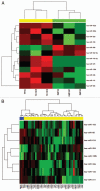MicroRNA signatures differentiate melanoma subtypes
- PMID: 21543894
- PMCID: PMC3233487
- DOI: 10.4161/cc.10.11.15777
MicroRNA signatures differentiate melanoma subtypes
Abstract
Melanoma is an aggressive cancer that is highly resistance to therapies once metastasized. We studied microRNA (miRNA) expression in clinical melanoma subtypes and evaluated different miRNA signatures in the background of gain of function somatic and inherited mutations associated with melanoma. Total RNA from 42 patient derived primary melanoma cell lines and three independent normal primary melanocyte cell cultures was evaluated by miRNA array. MiRNA expression was then analyzed comparing subtypes and additional clinicopathologic criteria including somatic mutations. The prevalence and association of an inherited variant in a miRNA binding site in the 3'UTR of the KRAS oncogene, referred to as the KRAS-variant, was also evaluated. We show that seven miRNAs, miR-142-3p, miR-486, miR-214, miR-218, miR-362, miR-650 and miR-31, were significantly correlated with acral as compared to non-acral melanomas (p < 0.04). In addition, we discovered that the KRAS-variant was enriched in non-acral melanoma (25%), and that miR-137 under expression was significantly associated with melanomas with the KRAS-variant. Our findings indicate that miRNAs are differentially expressed in melanoma subtypes and that their misregulation can be impacted by inherited gene variants, supporting the hypothesis that miRNA misregulation reflects biological differences in melanoma.
Figures




Comment in
-
MicroRNAs as molecular classifiers for cancer.Cell Cycle. 2011 Sep 1;10(17):2827-8. doi: 10.4161/cc.10.17.16574. Epub 2011 Sep 1. Cell Cycle. 2011. PMID: 21869596 Free PMC article. No abstract available.
-
New insights into the biology of melanomas using a microRNA tool-KIT.Cell Cycle. 2011 Sep 1;10(17):2828-9. Epub 2011 Sep 1. Cell Cycle. 2011. PMID: 21869597 No abstract available.
Similar articles
-
KRAS alleles: the LCS6 3'UTR variant and KRAS coding sequence mutations in the NCI-60 panel.Cell Cycle. 2012 Jan 15;11(2):361-6. doi: 10.4161/cc.11.2.18794. Epub 2012 Jan 15. Cell Cycle. 2012. PMID: 22189714
-
miRNA expression profiling of lung adenocarcinomas: correlation with mutational status.Mod Pathol. 2010 Dec;23(12):1577-82. doi: 10.1038/modpathol.2010.152. Epub 2010 Sep 3. Mod Pathol. 2010. PMID: 20818338
-
A 3'-untranslated region KRAS variant and triple-negative breast cancer: a case-control and genetic analysis.Lancet Oncol. 2011 Apr;12(4):377-86. doi: 10.1016/S1470-2045(11)70044-4. Epub 2011 Mar 22. Lancet Oncol. 2011. PMID: 21435948 Free PMC article.
-
MicroRNA profiling differentiates colorectal cancer according to KRAS status.Genes Chromosomes Cancer. 2012 Jan;51(1):1-9. doi: 10.1002/gcc.20925. Epub 2011 Sep 15. Genes Chromosomes Cancer. 2012. PMID: 21922590
-
MicroRNA-mediated regulation of KRAS in cancer.J Hematol Oncol. 2014 Nov 30;7:84. doi: 10.1186/s13045-014-0084-2. J Hematol Oncol. 2014. PMID: 25433809 Free PMC article. Review.
Cited by
-
Downregulation of microRNA-362-3p and microRNA-329 promotes tumor progression in human breast cancer.Cell Death Differ. 2016 Mar;23(3):484-95. doi: 10.1038/cdd.2015.116. Epub 2015 Sep 4. Cell Death Differ. 2016. PMID: 26337669 Free PMC article.
-
MicroRNAs as molecular classifiers for cancer.Cell Cycle. 2011 Sep 1;10(17):2827-8. doi: 10.4161/cc.10.17.16574. Epub 2011 Sep 1. Cell Cycle. 2011. PMID: 21869596 Free PMC article. No abstract available.
-
Effect of miR-142-3p on the M2 macrophage and therapeutic efficacy against murine glioblastoma.J Natl Cancer Inst. 2014 Jun 28;106(8):dju162. doi: 10.1093/jnci/dju162. Print 2014 Aug. J Natl Cancer Inst. 2014. PMID: 24974128 Free PMC article.
-
MicroRNA-Directed Cancer Therapies: Implications in Melanoma Intervention.J Pharmacol Exp Ther. 2018 Jan;364(1):1-12. doi: 10.1124/jpet.117.242636. Epub 2017 Oct 20. J Pharmacol Exp Ther. 2018. PMID: 29054858 Free PMC article. Review.
-
MicroRNA and cutaneous melanoma: from discovery to prognosis and therapy.Carcinogenesis. 2012 Oct;33(10):1823-32. doi: 10.1093/carcin/bgs205. Epub 2012 Jun 12. Carcinogenesis. 2012. PMID: 22693259 Free PMC article. Review.
References
-
- Liu V, Mihm MC. Pathology of malignant melanoma. Surg Clin North Am. 2003;83:31–60. - PubMed
-
- Esquela-Kerscher A, Slack FJ. Oncomirs—microRNAs with a role in cancer. Nat Rev Cancer. 2006;6:259–269. - PubMed
-
- Babar IA, Slack FJ, Weidhaas JB. miRNA modulation of the cellular stress response. Future Oncol. 2008;4:289–298. - PubMed
-
- Bartel DP. MicroRNAs: Genomics, biogenesis, mechanism and function. Cell. 2004;116:281–297. - PubMed
-
- Lu J, Getz G, Miska EA, Alvarez-Saavedra E, Lamb J, Peck D, et al. MicroRNA expression profiles classify human cancers. Nature. 2005;435:834–838. - PubMed
Publication types
MeSH terms
Substances
Grants and funding
LinkOut - more resources
Full Text Sources
Other Literature Sources
Medical
Research Materials
Miscellaneous
